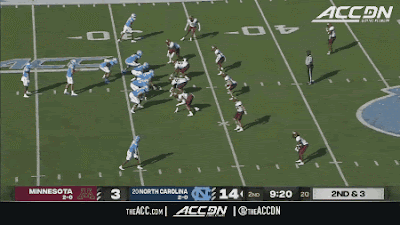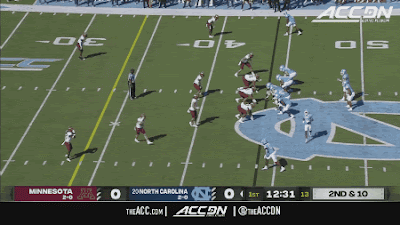This loss confirmed some of Gopher fans' greatest fears. In particular, the issues we saw from Minnesota's offense in the first two weeks of the season look serious — namely, the continued inconsistency of Athan Kaliakmanis and the whole unit's ineptitude near the goal line.
Kaliakmanis wasn't always well-protected, but he didn't handle pressure as well as he has in his previous games as a Gopher. Even when the pressure was marginal, Kaliakmanis rushed himself, frequently overshooting his targets or applying too much speed. On his interception, he put the ball behind and nearly over Brevyn Spann-Ford.
It was the third time in the last 12 months that a pass hit Spann-Ford's hand and ended up an interception, but it's fair to say this one was the quarterback's fault.
Kaliakmanis' accuracy and pocket presence weren't the only problems. He was late on his reads and looked away from open receivers. When kept totally clean, he delivered a few strikes to his receivers, and he still ran mostly effectively. But rather than a few little things being the difference between an okay performance and a strong one, as has been the case before, Kaliakmanis made repeated, game-killing errors. All while the UNC secondary looked just as vulnerable as it was expected to be entering the game.
It was, in Kaliakmanis' words, the worst game he'd ever played. He has two straight "get right" games before facing Michigan's menacing defense. He needs to take full advantage of the next couple of weeks and find a rhythm.
That stretch would also be a good time for Minnesota to fix their red zone problems. Playcaller Greg Harbaugh can only do so much about some of the moments that cost the Gophers: Daniel Jackson slipping on a whip route that looked like it would have scored, lapses on the offensive line (which was largely excellent run blocking in the open field), and his quarterback's aforementioned struggles.
But Harbaugh can be better. He'd make the line's job easier if he ran out of lighter personnel groupings and more spread out formations, rather than sticking with the heavy package for all three downs of a goal-to-go trip. He could introduce more creative concepts: rub routes, shovel passes, even some trick plays. He could end this program's apparent addiction to max-protect fades, which Harbaugh went back to as a give-up call on 3rd-and-goal.
 |
| Another bad throw from Kaliakmanis, who hasn't shown Tanner Morgan's aptitude for finding the back pylon. |
A lot needs to change, and it's not down to any one person. If the Gophers can't finish drives with touchdowns, they're going to lose.
Which, once again, comes back around to P.J. Fleck. Fleck mentioned plenty of times the talent on the opposing offense last week. He did not, however, take that as a reason to try and maximize his team's scoring output. Instead, it was another reason to again retreat to kicking field goals just to say he came away with points, and to punting when he needs to keep the ball.
Fleck kicked an early 23-yard field goal down two possessions, which kept it a two-possession game. Three times, the Gophers punted from near or beyond midfield, including a galling 4th-and-3 decision when they were down two possessions with just over 10 minutes left. The next time Minnesota got the ball, it was a three-score margin, and the game was practically over. While Minnesota's players weren't as effective as they needed to be to win on Saturday, their coach consistently makes their task harder with timid game management.
North Carolina's offensive approach, much faster and more open than what Minnesota is used to in the Big Ten West, was arguably the mismatch that decided the game. The differences in style made the fight, but offensive coordinator Chip Lindsey attacked the Minnesota defense in a way that heightened the effect of those differences.
To begin with, the Tar Heels went to the hurry-up in short-yardage situations to catch the Gophers by surprise. In the former case, the UNC offensive line got a jump on their opponents on quarterback sneaks, and they converted those opportunities easily.
The increased pace also came into play on 3rd downs. In passing downs, defensive coordinator Joe Rossi often brings in four or five new players to be lighter and faster in the pass rush and in coverage. On UNC's third drive, Minnesota forced 3rd-and-6 and made their substitutions. The problem: UNC didn't make any substitutions, so the officials did stand in the way of the snap to give the Minnesota the time for their subs.
When Drake Maye received the snap on the following play, the Gophers weren't remotely set. Deep safety Aidan Gousby, trying to get the call from the sideline, realized too late that Komari Morales was streaking past him on a post route. Maye found his man easily.
All afternoon, 3rd down was a problem for Minnesota. The Tar Heels converted 12 of their 17 3rd downs despite facing an average 3rd down distance of 5.1 yards. If you remove their one 3rd-and-20, a major outlier, that average distance was practically the same as what Minnesota faced.
The varied tempos were only part of the problem. Sometimes, it just helped UNC that they had one of the nation's best quarterbacks. Maye didn't play a perfect game but usually made quick reads and delivered accurate passes. Here, his receiver settled into a space between Minnesota's cornerback and rush end, the latter of whom (Chris Collins) probably should have gotten a little wider dropping into his zone.
When Minnesota's pass rush couldn't get home quickly or keep Maye in the pocket, Maye was quick enough to buy time and pick up 1st downs himself if available.
The Gophers' young defenders didn't always take great angles to the ballcarrier or to where the ball was headed, in part because of Lindsey's playcalling. Linebacker Maverick Baranowski and safety Darius Green, both heatseeking players in a defense that coaches its players to aggressively come downhill, got burned on UNC's third touchdown. Baranwoski and Green closed on what they thought was a bubble screen at the snap, even before Maye's pump fake, and that left Bryson Nesbit open on a wheel route.
By halftime, the Tar Heels had enough points (21) to ultimately secure the win. They weren't quite as effective in the second half, averaging just 5.7 yards per play compared to 7.8 in the first half, which did reflect some improvements from the Gophers. There were fewer explosive plays, and the Gophers kept their opponents in check just enough for a comeback to be theoretically possible. A sputtering offense couldn't overcome those early breaks.
Minnesota's defense was solid against the run, at least. One of the challenges North Carolina presents is that as good as Maye and his receivers and tight ends are, they are not the only way the Tar Heels can hurt opposing defenses. In a Week 2 win where Maye couldn't throw for a touchdown, Omarion Hampton ran for three, as 234 yards.
Minnesota, meanwhile, had not been terribly impressive the first two weeks of the season against Nebraska and Eastern Michigan's rushing attacks. In the latter case, it was partially a consequence of strategy: The Gophers stayed back to play the pass, which in turn opened up space for the Eagles to run. But Nebraska was a different story. Minnesota allowed 7.3 yards per carry to a mobile quarterback, which was the Huskers' main route forward.
Maye's legs still hurt the Gophers. But his rushing total was only 45 yards. Hampton had just 46. Strong work from tackles Kyler Baugh, Deven Eastern, and Logan Richter kept the Tar Heels in check on the ground.
The Gophers still need to create more negative plays. As long as Cody Lindenberg is missing from their linebacking corps, they'll keep missing more tackles than they should and keep taking iffy pursuit angles. The short-yardage problems are worrisome. Mobile quarterbacks still give them fits.
Even so, to allow just one run of 15-plus yards against a seemingly improved and explosive rushing attack, and to hold them to a below-average 37 percent success rate on the ground despite their missed tackles, shows that Minnesota still has some strength in the box. Once Lindenberg is back, they might be good to go against the meaner, meatier lines of the Big Ten.
 |
| You can find explanations for each stat here. Line yards and success rate are via collegefootballdata.com. |
After a couple unremarkable games, Jack Henderson showed what he can bring to the Gophers. This was often a trying day for the Minnesota secondary, and that did include Henderson at points. But he stepped up and played his best game since joining the team, leading all players with 9.5 tackles (8 solo) and making his first FBS interception. On UNC's first drive, he expertly read a screen and blew it up for a tackle for loss.
The Gophers' nickelback position requires a player who can play alongside the linebackers in the box. That requires some physicality and technique that I was skeptical Henderson could bring. He read plays well at Southeastern Louisiana, however, and he has the athleticism to always be in position to make plays. If he's cleaned up his tackling since coming to Minneapolis — and it looked quite sound on Saturday — he can be a real asset.
So far, Dragan Kesich is working. It's tricky evaluating kickers or guessing what they might be when you've only seen them try to do their job a few times. To use an example relevant to Minnesotans, one of the best kickers in college could play like one of the worst kickers in the pros for a few weeks only to end up one of the best kickers in the pros after joining a new team. It's a small-sample position whose output and sole evaluation criterion is a binary: Did they make the kick, or did they not? There are so many factors that go into it that kickers only have so much ability to overcome, but ultimately, we judge them based on their success rate on field goals and extra points.
What we knew about Kesich coming into the season was that he had a lot of power in his left leg. What we didn't know is if he could use that leg to consistently put the ball through the uprights. We still don't totally know that, since Fleck has had Kesich try four field goals that were shorter than 30 yards — chip shots that we'd expect any competent kicker to convert almost every time. But for now, Kesich is 7-of-8 on field goal attempts and 4-for-4 on PATs, having only failed on a 54-yarder that didn't miss by much. He hit from 45 yards in this game.
College kickers have a habit of proving wrong anything good or bad we say about them within the same game, let alone week to week. This early run may not last, just as any subsequent slump waiting for us behind the corner may not. But right now, Minnesota's kicking situation looks as secure as you could want it to look through three games.









No comments:
Post a Comment
Note: Only a member of this blog may post a comment.